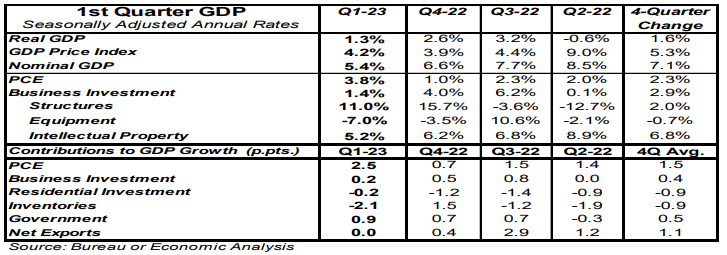- Real GDP growth in Q1 was revised higher to a 1.3% annual rate from a prior estimate of, and consensus expected, 1.1%.
- Upward revisions to inventories, business investment, government purchases, and consumer spending more than offset downward revisions to net exports and home building.
- Personal consumption, business fixed investment, and home building, combined, rose at a 3.0% annual rate in Q1. We refer to this as “core” GDP.
- The GDP price index was revised up to a 4.2% annual growth rate from a prior estimate of 4.0%. Nominal GDP growth – real GDP plus inflation – was revised up to a 5.4% annualized rate from a prior estimate of 5.1%.
Implications:
Real GDP was revised higher for the first quarter to a 1.3% annual rate from a prior estimate of 1.1%. The upward revision to the overall number was due to the cumulative effect of a series of small upward revisions to inventories, business investment, consumer spending, and government More important, today we also received our first look at economy-wide corporate profits for the first quarter, which declined 5.1% versus Q4, and are down 2.8% from a year ago. The government includes Federal Reserve profits in this data, and the Fed is making losses. So, we follow profits excluding those earned (or lost) by the Fed, which are still up 7.0% from a year ago. However, profits excluding the Fed declined 2.7% in Q1, the largest drop for any quarter since 2020. Excluding the Fed, domestic non-financial companies’ profits fell the most. Moving forward, we expect further declines in corporate profits as the economy continues to re-normalize after the massive fiscal and monetary stimulus of 2020-21. In turn, this will be a headwind for equities. In addition to corporate profits, we also got a Q1 total for Real Gross Domestic Income, an alternative to GDP that is just as accurate. Real GDI fell at a 2.3% annual rate in Q1 and is down 0.9% versus a year ago, consistent with underlying economic weakness. These are figures that are normally seen in and around recessions. Regarding monetary policy, inflation remains stubbornly high. GDP inflation was revised higher to a 4.2% annual rate in Q1 versus a prior estimate of 4.0%. GDP prices are up 5.3% from a year ago, nowhere near the Fed’s 2.0% target. Meanwhile, nominal GDP (real GDP growth plus inflation) rose at a 5.4% annual rate in Q1 and is up 7.1% from a year ago. In employment news this morning, initial claims for jobless benefits rose 4,000 last week to 229,000. Continuing claims declined 5,000 to 1.794 million. As for other economy-wide news, the Fed recently reported that the M2 measure of the money supply dropped 0.8% in April, is down 4.6% from a year ago, and is down at a 6.3% annualized rate from the peak in July. Not only have we never experienced a Fed trying to fight an inflation problem under an abundant reserve regime, we’ve never seen M2 grow so fast for so long, or decline so rapidly, at least since the Great Depression. If the recent data are accurate, this is not a good sign for Real GDP growth in the year ahead and consistent with our view that we’re headed for a recession.





